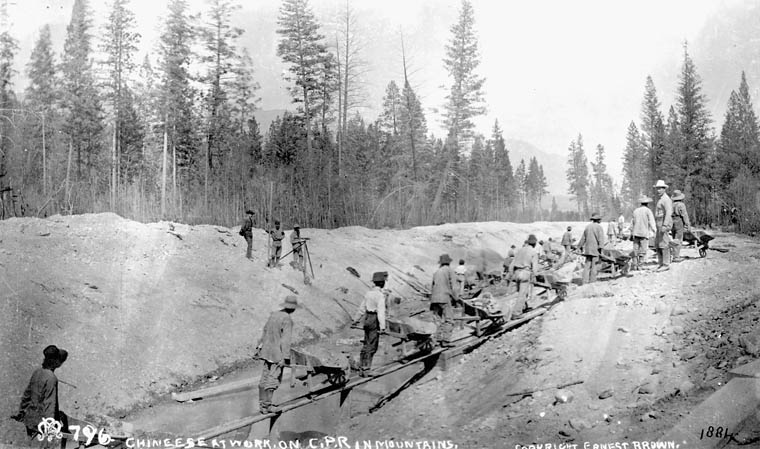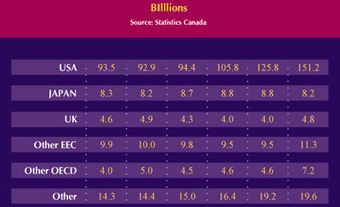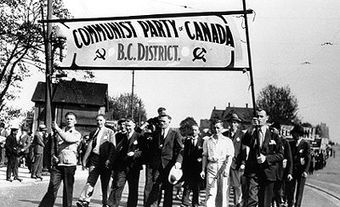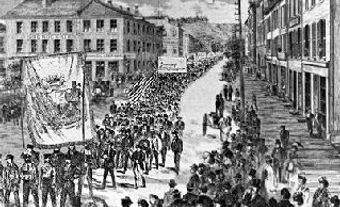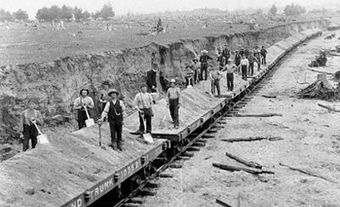Capitalism is an economic system in which private owners control a country’s trade and business sector for their personal profit. It contrasts with communism, in which property effectively belongs to the state (see also Marxism). Canada has a “mixed” economy, positioned between these extremes. The three levels of government decide how to allocate much of the country’s wealth through taxing and spending.

In an unsigned cartoon published on 29 July 1880, Prime Minister Sir John A. Macdonald (1815–91) holds hands with a figure who is presumably Quebec Premier Sir Joseph-Adolphe Chapleau (1840–98). Both hold miniature locomotives, representing the Canadian Pacific Railway, which was being planned at that time. The cartoon appeared in the Canadian Illustrated News and its French counterpart, L'Opinion Publique. More information on image M993X.5.794.
Origins of Capitalism
The English terms capitalist and capitalism first appeared with the industrialization of Britain in the 18th and 19th centuries. One can argue, however, that capitalism’s origins date back much further. The tools and goods that ancient humans produced were a form of wealth. People could use or trade these items for their own benefit.
Capitalism in which the government takes a hands-off approach to the economy is sometimes called laissez-faire. However in practice, government regulations, taxation and monetary policy interventions throughout history have made laissez-faire a theoretical concept at best.
History of Capitalism in Canada
In its early years, Canada was a colony that traded natural resources. This trade contained elements of merchant capitalism (see Mercantilism). In this economic system, French and then British colonizers profited by exporting fish, wood, fur and other items. These commodities supplied European markets. Trade with any nation but the mother country was restricted. In the seigneurial system of New France, property belonged to a small landholding class. Canada abandoned this system as the population grew. Larger private-sector operations such as sawmills, shipyards and factories began to appear.
Capitalism gained a firm foothold in Canada in the 19th century. Industrialists such as John Molson played a crucial role in fostering the country’s first railways and steamships. These innovations in the transportation of goods allowed for the growth of manufacturing. Canadians began to produce and sell their own goods where before they had sent the raw materials to Britain. With this new capacity, the private sector grew. Over time, industrialization brought Canada’s railway system to the West Coast. Railways were key to the process of Confederation. (See also Railway History.)
The Great Depression of the 1930s changed the views of many economists and policy-makers. They began to see the need for more intervention in capitalist business cycles. In Canada, as in many other countries, the high unemployment of the decade created great hardship. The Depression led to a larger state role in economic regulation and social programs. This role expanded after the Second World War (see Welfare State).
The progress of capitalism in Canada and much of the Western World during the past half century has coincided with the growth of government. The private sector competes with the government for resources. According to the Fraser Institute, Canadians worked almost half the year in 2019 to pay their taxes. This fact suggests that, today, the public and private sectors are in rough balance.
Arguments for Capitalism
Proponents argue that capitalism works for a variety of reasons.
A main reason is its positive incentive structures. The “profit motive” is a prime example. Individuals benefit directly from the fruits of their labour, frugality and creativity. By contrast, cases of collective farming around the world offer examples of systems that lack this incentive. They prize social equality over personal profit. Studies of these cases suggest that collective farming has often been less efficient than private farming.
Another argument for capitalism is the process that economist Joseph Schumpeter called “creative destruction.” In this view, the bankruptcy of inefficient businesses is a net positive. It is “creative” because it forces poorly performing entrepreneurs and workers to readjust their strategies.
Proponents also point to key weaknesses of other economic systems. Economist Ludwig von Mises argued that socialist economies would ultimately fail. He attributed this to the problem of economic calculation. In his theory, a free market in currencies gives governments a stable benchmark. For example, changes in prices signal the scarcity or abundance of goods and services. Von Mises thought that socialist governments could not effectively allocate resources without such a measure. Those who share his view cite the poor economic performance of Eastern European countries under Soviet domination during the Cold War. Their planned economies did not fare as well as the more open economies of Western Europe.
The introduction of capitalist features into an economy have in the past coincided with vast increases in collective wealth. Examples of such features are enhanced property rights and freer markets. Great Britain during the industrial age, the opening of the ex-Soviet Bloc countries in the 1990s, and China in recent decades all show this trend.
Challenges to Capitalism
Critics such as John Maynard Keynes have argued that capitalism fosters large boom-and-bust cycles. During their low periods, these cycles drive massive unemployment and human suffering. Most contemporary economists and policy-makers share Keynes’s view. (See Keynesian Economics in Canada.)
Critics also blame the excesses of capitalism for growing global inequality. A 2018 report by the Canadian Centre for Policy Alternatives studied the growing wealth gap in Canada. The authors found that the country’s wealthiest 87 families owned as much as the 12 million lowest-earning Canadians. The report noted that capital gains (wealth earned from assets) were taxed at half the rate of income from labour. Such a policy allows wealth to continue to concentrate among the wealthy.
Capitalism’s links to environmental ruin is another focus of criticism. The United Nations’ Intergovernmental Panel on Climate Change has attributed rising greenhouse gas emissions to “the spread of fossil-fuel-based material consumption and changing lifestyles.” Some critics have argued more explicitly that unbound economic growth contributes to climate change. A prominent advocate of this view is Canadian journalist Naomi Klein. Klein makes this case in This Changes Everything: Capitalism vs. The Climate (2014).
In recent years, challenges to capitalism have increasingly come from government monetary policies. Policy actions distort consumer and asset prices throughout the economy. This leads to wealth transfers that are difficult to quantify and thus not studied in great detail.

 Share on Facebook
Share on Facebook Share on X
Share on X Share by Email
Share by Email Share on Google Classroom
Share on Google Classroom

